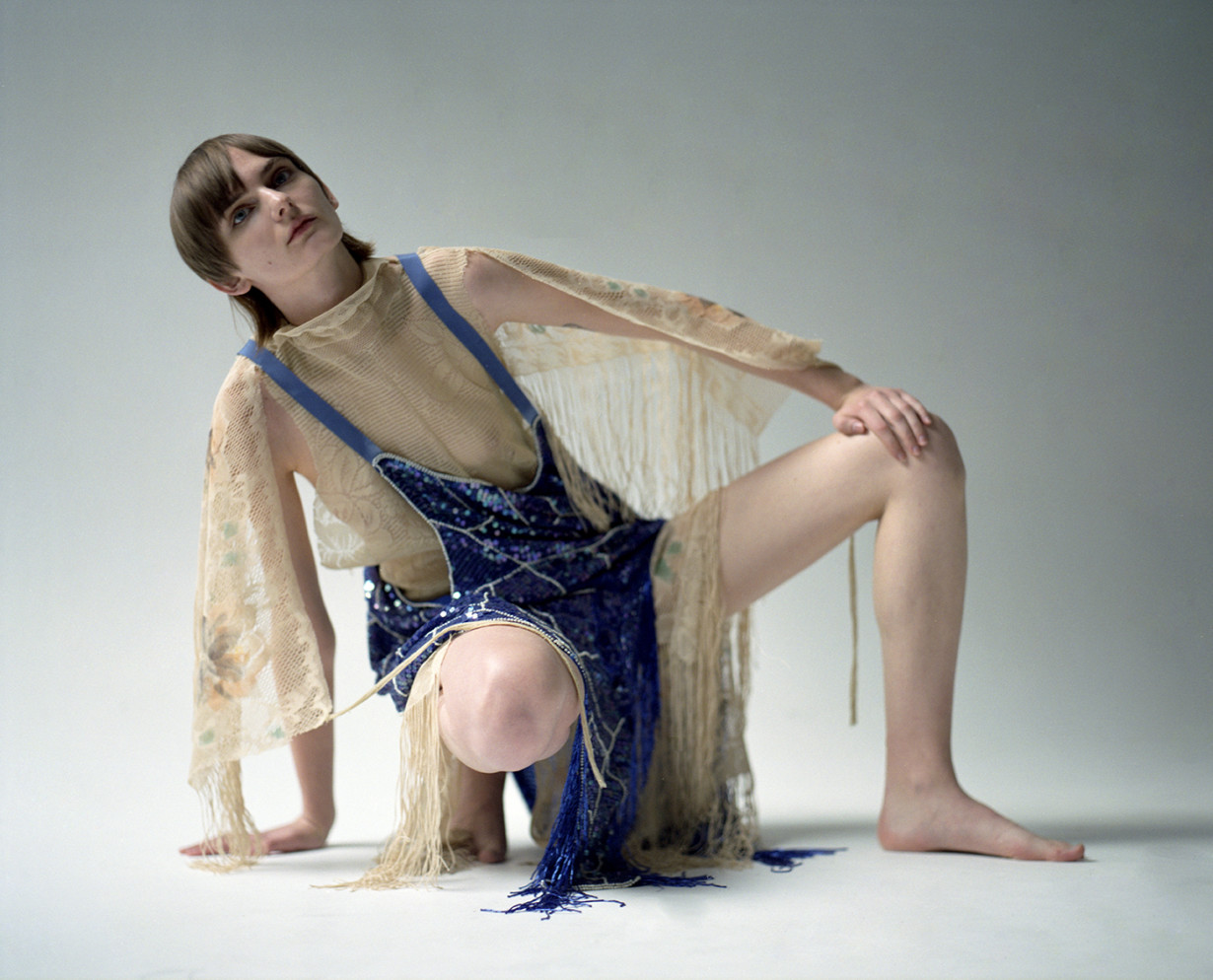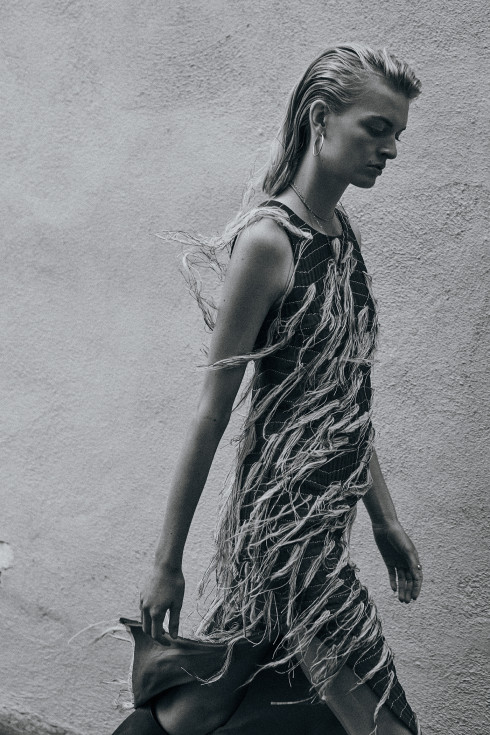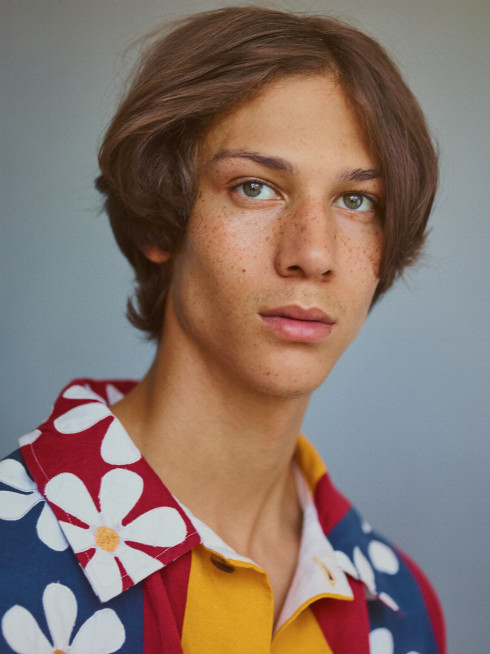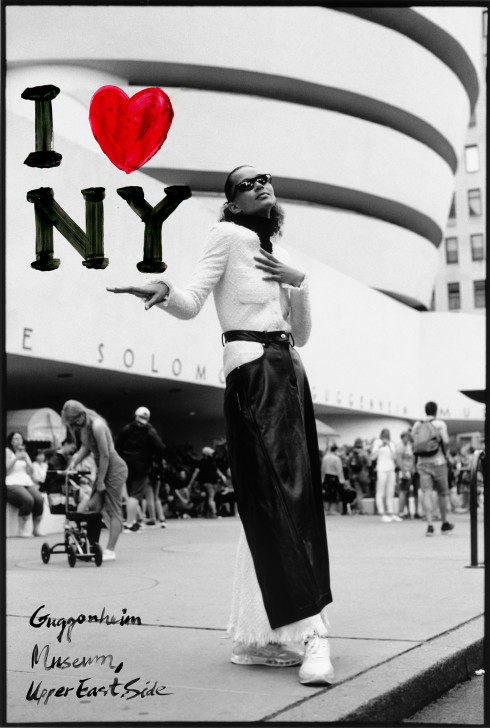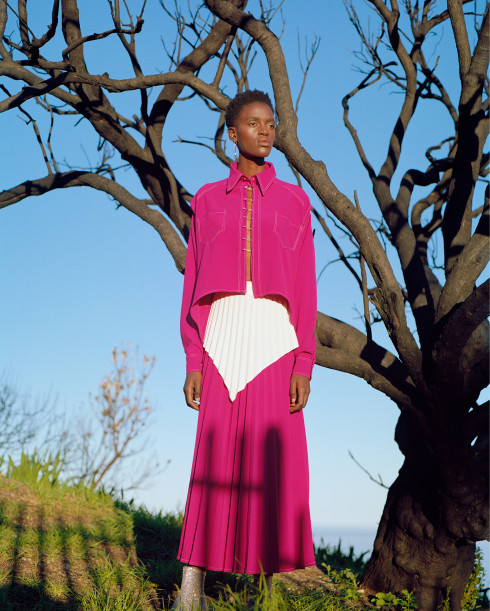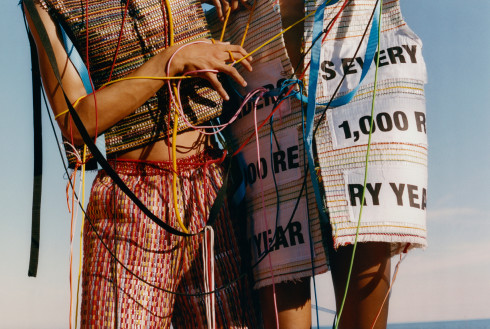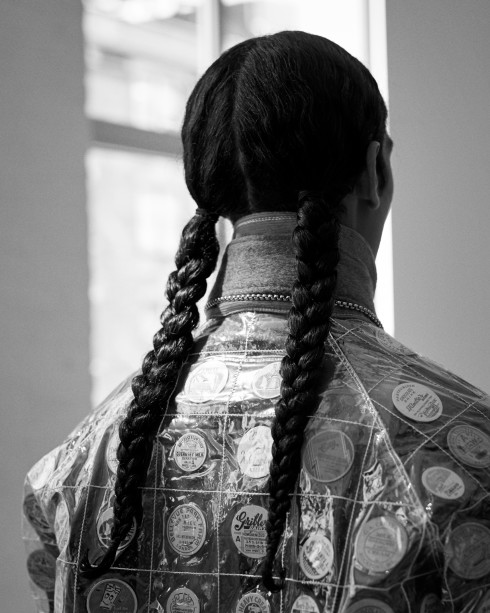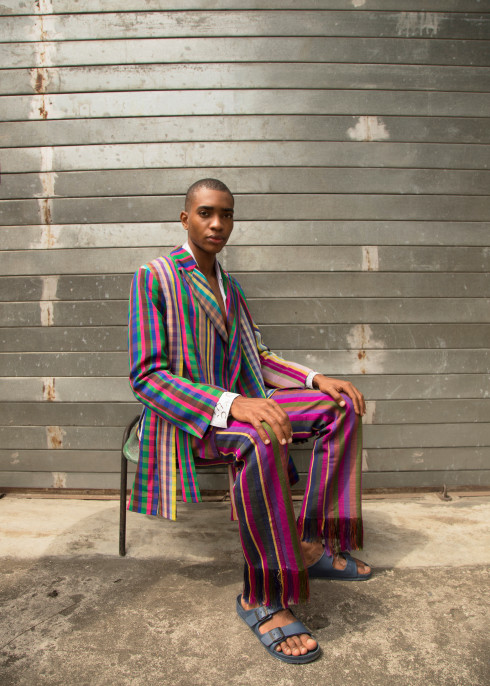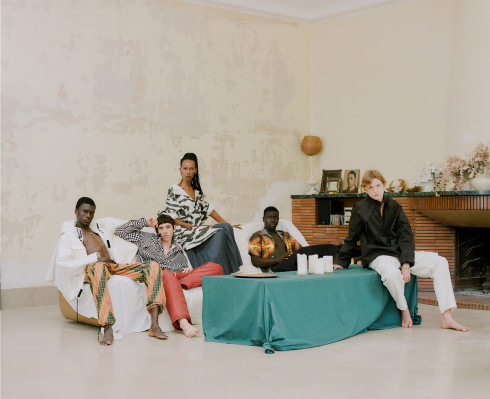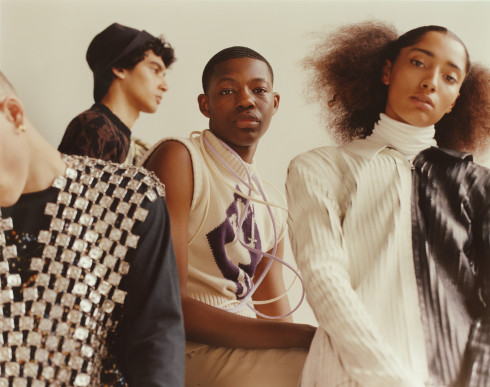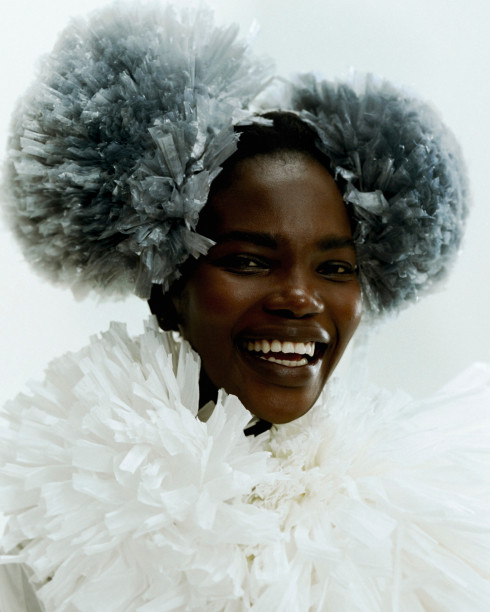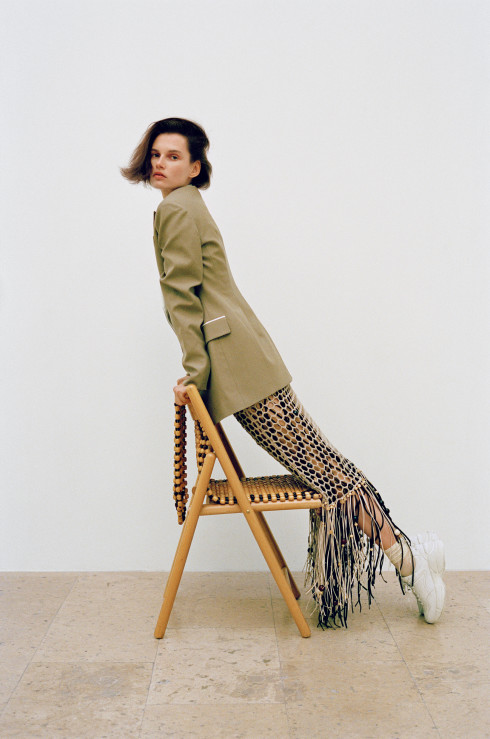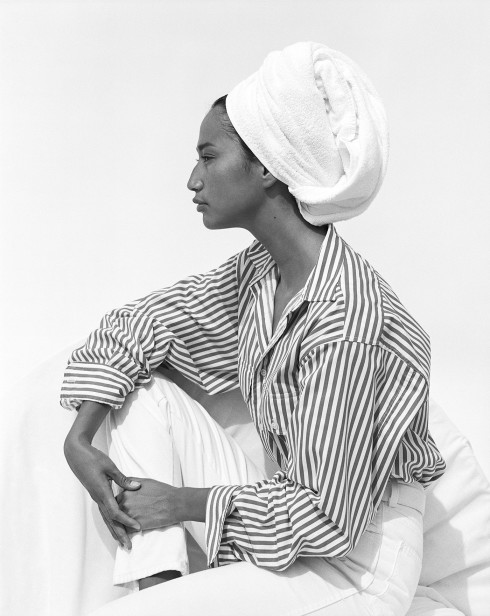- By
- Gautam Balasundar
- Photography by
- Anna Victoria Best
- Styling by
- Martina Almquist
Model: Oliwia Lis at Ford Models. Hair by Michael Delmas at Atomo Management. Makeup by Fanny Mauer at ArtList. Casting by Nicolas Bianciotto at Art Board.
Conner Ives Finds Beauty in America
It wasn’t that long ago that quitting fashion was on the table for Conner Ives. A tumultuous year at the esteemed Central Saint Martins in London tested his convictions, but of course, he persevered, and that persistence paid off: His designs have been garnering attention ever since, most notably when Adwoa Aboah wore one of his custom pieces to the Met Gala in 2017 and turned the industry’s eyes onto him overnight. His unique, coveted creations are almost as impressive as the fact that the 22-year-old Ives is still a student at CSM, juggling coursework and his own collections. His fervent commitment to his design ethos makes him an exciting prospect, with flashes of that talent signaling what’s to come.
Ives has been fascinated by fashion for as long as he can remember. As a child, his mother’s interest was influential and he considers it to have been his primary education. His Bedford, New York, upbringing informed the design principles which he still holds onto today. “I was always a product person,” he says. “I was always I think American in the idea that anything I made was to be worn. Nothing was an art piece or wearable art. I hated that and I hated how pretentious that sounded and that was never what I wanted to do because I think even really good design that people wear takes a lot of consideration and a lot of work to develop, and that was always my mantra in going about it.” As he got older, he began making his own designs, initially for girls at his high school, and they became the DNA for his current work. “You can go back to stuff that I was making at like fifteen or sixteen and I would still proudly stand behind that to this day,” he asserts. “There was really no point where I was like, ‘Oh I don’t really believe in that anymore.’ The æsthetic hasn’t really changed at all.”

For Ives, attending Central Saint Martins was always the dream: “I got it into my head when I was twelve or thirteen that I wanted to go to Saint Martins in London, never really knowing what the meant or how difficult that would be, understanding that London sounded cool and all of my favorite designers went to this school.” His idealized version of the institution was soon challenged during his first year, also known as foundation year. “You start to realize that maybe this reputation is more like hot air than anything else because while it was a really tough environment to be in there was nothing really that reflected that,” he says, referring to the coursework itself. He also felt like a cultural misfit and his æsthetic was already more formed than others, which led to friction. “What was really frustrating about that year was they really wanted me to change” he adds. “They really wanted me to be this British, crazy, wacky, you-don’t-even-understand-that-it’s-clothing-anymore type of designer, so I wanted no part of that.” His commitment to his own designs didn’t always mesh with his professors. “Everything they said about my work, ‘It’s too sexy, too this, too that,’ [they] drew all these conclusions without even talking to me or understanding what it was,” he recalls. “‘Too American, too simple’…at the end of the day, they used every quote in the book to describe my work.”
The irony of criticizing a school while remaining enrolled of his own free will is not lost on Ives. “Even when people hear me talk about it, they’re like, ‘You still go to that school, why are you trashing them so much?'” he admits. “Once I finished that year, I wanted to quit. [I was like,] ‘Ok, but you’ve wanted this for so long, maybe think about this a bit more before you make a decision.’” That summer, Ives applied to the equally renowned Royal Academy of Fine Arts in Antwerp, eventually passing the famously rigorous admission test. “I got really positive critiques from them, so it was the feeling of like, ‘Wait a minute, maybe it isn’t me, maybe it was just this year. Maybe I need to try it again, look at it differently,'” he recalls. He decided to return to Central Saint Martins, now with a different outlook. “After it all passed, I started to understand that maybe this year of confusion and delirium and insomnia was a good thing because maybe I wasn’t ready or maybe they weren’t ready for me,” he explains. “Eventually I got to a place where I was surrounded by tutors that got it.” Ives still looks back at that first year with some frustration but recognizes that it was a pivotal time that shaped his design career: “I had this extra year that was quite lucky where I could hone my æsthetic to a point that I was so sure of it that no one was going to question my work again. That year was the reason that everything that happened after happened. If I didn’t have that year, none of this would have happened.”
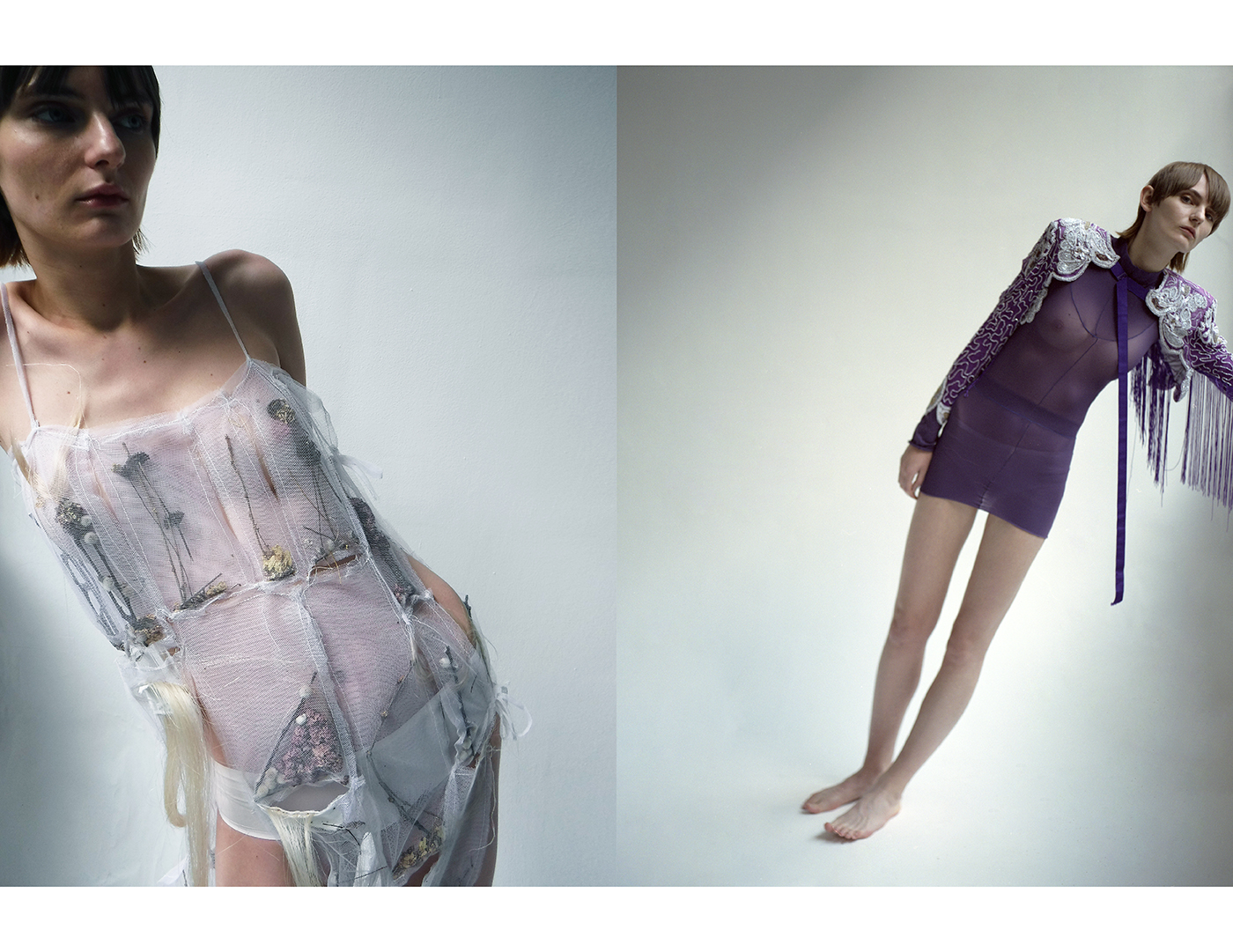
Now Ives is balancing his studies while still honing his own vision with one-off pieces he designs on the side, including capsule collections he’s created for Liberty London and Browns. His Instagram account has helped him gain attention, coinciding with a small collection he created and posted about right before his first BA year at Saint Martins. “Before that, I had done things that were never serious,” he explains. “This was a six-look collection and this was a titled collection with things I was super proud of. Even in that collection was the first t-shirt dress. When people start to ask, “Where does this come from? Where do the silhouettes come from?’ it’s funny for me to look at it and realize that it’s kind of been around for years and it’s ideas I’ve worked on for years.”
At a time when American culture is being reinterpreted through fashion by many designers, Ives is working to find something new in it. His version blends graphics and sequins and minidresses from the Eighties with a rural vision of fringe, pointed boots, and cowboy hats. “People will look at me with wide eyes when I say I totally find American culture romantic,” he offers. “The little blip we’re in right now, it doesn’t seem romantic, but me myself I am a quite overtly romantic person. Even if America was burning at the foundation, it was upside down, something we didn’t recognize anymore, I’d probably still look at that and be like, ‘Oh no but it’s beautiful.’ It sounds super clichéd, but in these moments of grave terror, we do start to look closer at the beauty of it.” This attitude is rooted in his upbringing. Unlike many creatives who end up in big cities, Ives retains a fondness for his upstate community, including its mainstream fashion ideals. “The people I was surrounded by had their code that reflected American design functionally and was still beautiful at the end of the day,” he elaborates. “I loved that people around me had this really studied, really developed fashion code that isn’t fashion in the way we see high fashion.”

Part of Ives’s fascination with American culture manifests in the way he sources fabrics, often times reconfiguring vintage pieces. The items he’s gained the most fame for, his t-shirt dresses, were born out of vintage shops, resulting in the uniqueness of each garment. For Ives, the reasoning is equal parts æsthetic direction and reducing waste, a movement that’s blossoming within a certain age group that is seeking a look not easily replicable online and is more conscious of consumption than ever before. “I think it is a generational reaction to the atmosphere of our current day,” he reasons, “instead of producing more from something that doesn’t exist yet, taking something that’s already out there and then twisting it or finding a way to put it out there again.” The process also lends itself to a style that is less precious and more youthful than the high fashion of the past, not unlike what other young designers have been doing in New York and London. “It’s just a way of us kind of throwing out the codes,” he says. “I’m always nervous to say that because I’m not throwing out the codes entirely. I respect the codes and think there’s something to the codes—the codes got us to the present day. I’m always trying to explore how I can take something super classic and just have someone see it in a light that they had never seen it in before. That’s really my main goal at the end of the day.”
“I will probably be making clothes or be in fashion in some way until the day I die,” Ives states with certainty. “It is in no way something that I won’t be doing.” That much is clear and Ives wouldn’t be taking on the projects he’s engaged in if there wasn’t a deep passion behind them, but how ‘Conner Ives’ develops as a brand is still to be seen. For now, he just wants to focus on graduating so he can end that chapter of his life and let the next one begin. “While I might not want it to be a brand yet, it really is. Whether I like that or not, it’s out there,” he says. “People will draw from that what they will. I really started to let that go. Let them see it however they want to see it. I’m really starting to let that go and let it evolve organically.”
For more information, please visit ConnerIves.com.

- By
- Gautam Balasundar
- Photography by
- Anna Victoria Best
- Styling by
- Martina Almquist
Model: Oliwia Lis at Ford Models. Hair by Michael Delmas at Atomo Management. Makeup by Fanny Mauer at ArtList. Casting by Nicolas Bianciotto at Art Board.
